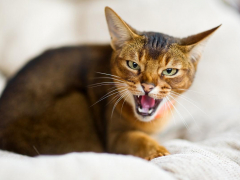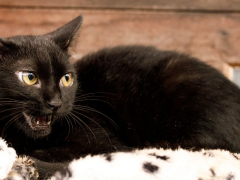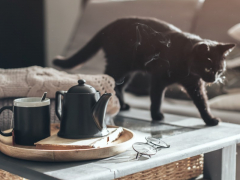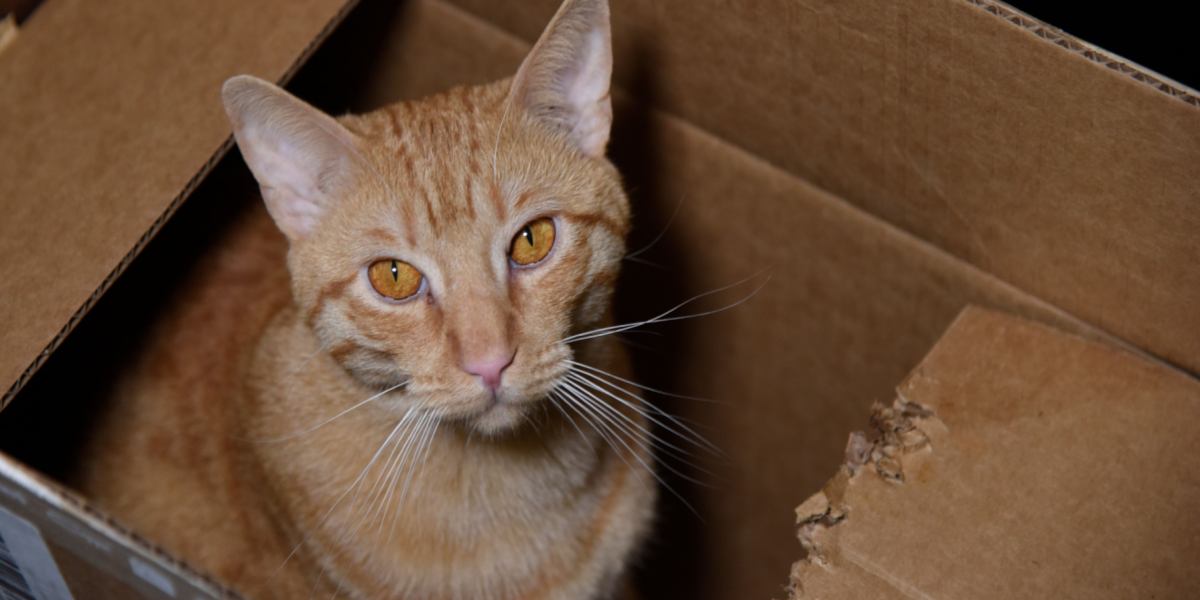
Your cat is chewing cardboard again. Should you be worried or is this just a bit of fun? There is no doubt that our feline friends can be curious creatures with perplexing habits!
Eating objects that are not food, such as cardboard and paper is known as pica, and the reasons behind this bizarre behavior can be complex and varied.
Read on to discover the most common reasons why your kitty has developed a taste for cardboard:
1. He’s Just a Kitten and Cardboard Is Fun!
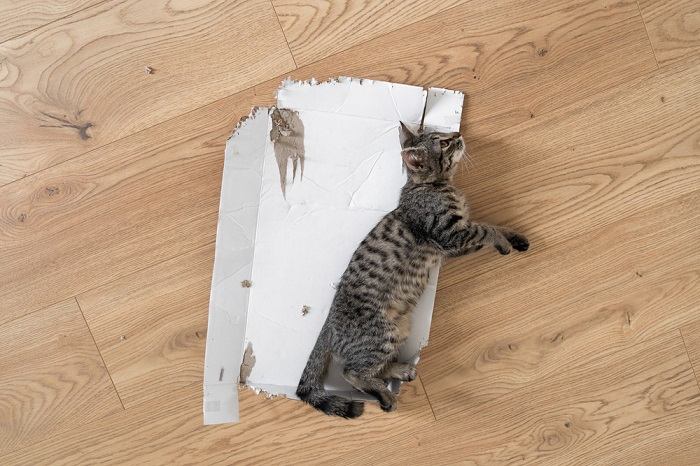
Kittens to tend to explore with their mouths and also chew when teething.
Kittens are mischievous and what’s more exciting than a cardboard box to jump in, chew on, and generally clown around with?
Growing kittens tend to be less discerning than adult cats and their increased energy requirements, coupled with their inquisitive nature, might lead them to chew non-edible objects. If your kitten is teething and has sore gums, the chewing action might even be soothing for him.
Also Read: Why Do Cats Like Boxes? 8 Reasons Why!
Early weaning might lead to habitual suckling on objects like fabric and may progress to pica as your kitten grows older, but there is no convincing scientific evidence for this yet. In addition, an increase in parasites in your kitten’s gut might motivate them to chew indiscriminately and regular worming might keep this at bay.
Also Read: 6 Best Cat Dewormers
2. Your Cat Is Expressing His Inner Tiger!
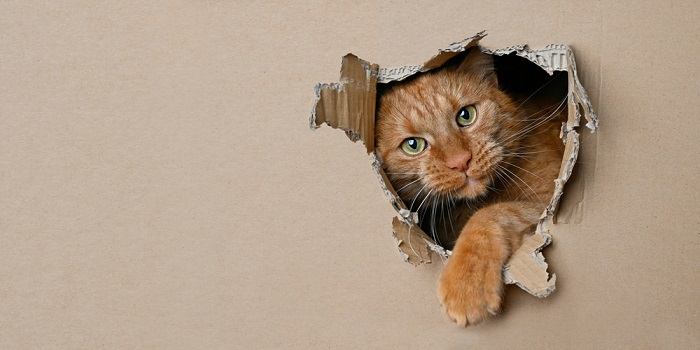
Some cats scratch and chew cardboard as a form of play hunting.
Domestic cats still experience a strong hunting drive. An opportunity to express this predator behavior is a chance not to be missed! Some cats enjoy scent-marking objects around the home whilst others are driven to hunt prey—be it real or pretend.
Our feistier felines may delight in destroying cardboard boxes: pouncing, shredding, and batting small pieces around like a ping pong ball! It’s OK if your cat is more about the shredding than the chewing, but when he starts eating the cardboard, it’s time to step in.
Also Read: What To Do If Your Cat Chews On Everything
3. Could It Be a Compulsive Disorder?
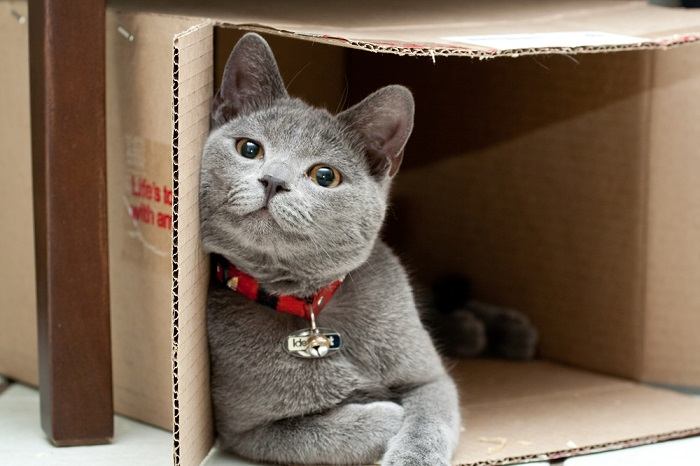
Some cats fine the unique texture of cardboard irresistible.
Much like obsessive-compulsive disorders in people (OCD), it is generally accepted that some cats demonstrate an unusually strong compulsion for pica. Just as we might have a preferred type of takeout food, cats will often favor particular objects according to their smell and texture.
Also Read: Repetitive, Excessive And Compulsive Grooming In Cats
This behavior is likely linked to genetics, appearing more commonly in oriental breeds, such as Birman and Siamese cats. The act of chewing items with a particular texture is thought to release happy chemicals in the brain and your cat might be determined to seek out this material at all costs!
4. Your Cat Is Missing Something From His Diet
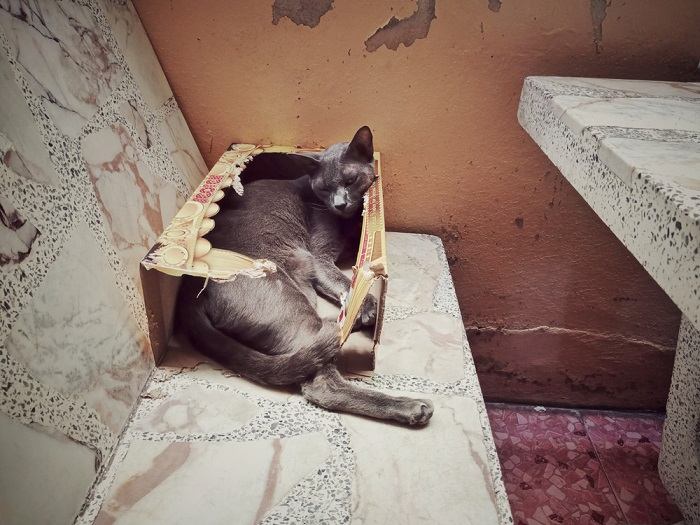
When cats seek out non-food items, it could be caused by nutritional deficiencies.
Less commonly, cats that have nutritional deficiencies might seek out non-food items to effectively fill the gap. Of course, our furry pals may not be the best judge of what they need.
Cats are obligate carnivores (or exclusive meat eaters) and have very specific dietary requirements. For example, amino acids, such as taurine, are required as building blocks for important proteins in the body.
Cats are unable to synthesize these nutrients themselves and so a good quality complete cat food is essential.
5. Your Cat Is Feeling Bored
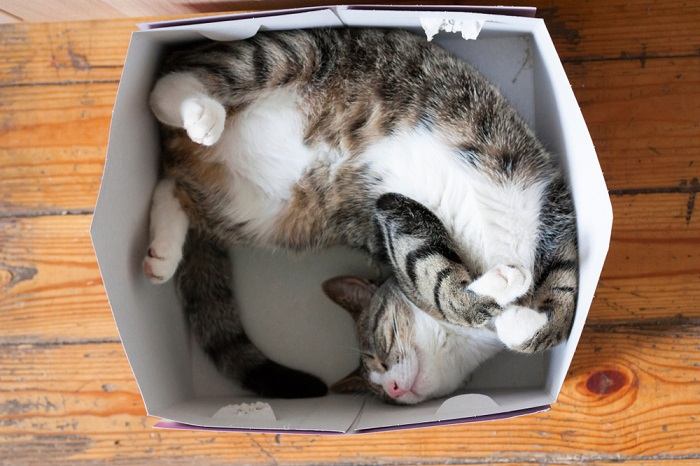
Your indoor cat might chew on cardboard simply out of boredom.
Cats are active animals who enjoy play, exploring, hunting, and all kinds of sensory input. These needs are often met during their outdoor adventures. Cats confined to indoor spaces are far more likely to find novel ways to entertain themselves and hence are more prone to pica.
Also Read: The 5 Best Outdoor Cat Houses
Put simply, chewing cardboard may be a sign of boredom and repeated behaviors may develop into habits over time, particularly if the outcome is comforting or fun.
6. Your Cat Is Feeling Stressed or Anxious
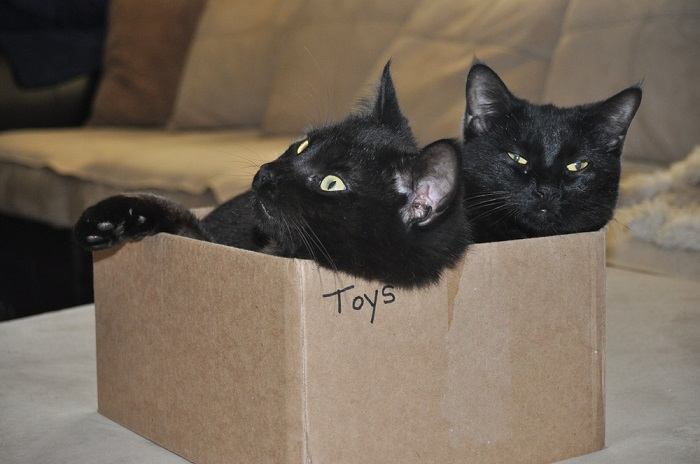
Some cats begin chewing in an attempt to relief stress or anxiety.
Habitual and repetitive behaviors might also be a sign of anxiety in your pet. Perhaps you are doing some home renovations, or there is a new tom cat on the block encroaching on your cat’s territory?
Whatever the reason, stress can lead to a whole host of abnormal behaviors including hiding away, excessive grooming, and chewing or eating objects. It’s no wonder if the act of chewing releases feel-good chemicals that your cat is chewing to calm their anxiety.
Also Read: Do Cats Have Scent Glands In Their Paws?
7. There’s Something Medical Going On
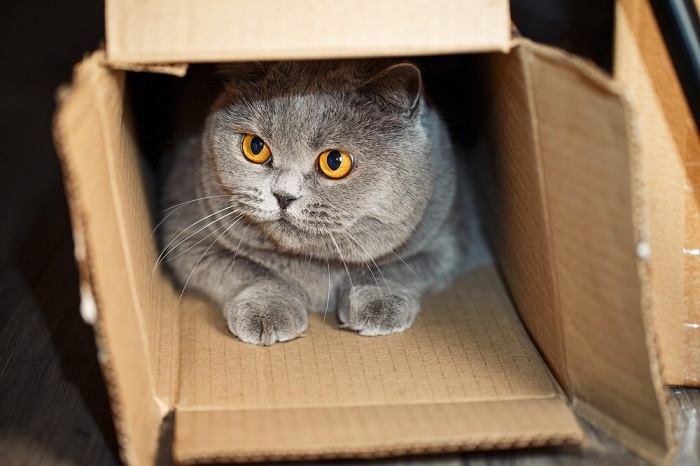
If your cat suddenly starts chewing on non-food items, schedule a vet checkup to make sure it isn’t being caused by a medical issue.
Occasionally chewing cardboard could be a sign of an underlying medical condition. Hyperthyroidism (high thyroid hormone levels) and diabetes can lead to excessive hunger, whereas viral conditions, some cancers, and brain disease (including aging) may lead to unusual behaviors including pica.
Dental disease is common in adult cats, and like teething kittens, cats can develop gingivitis (inflamed gums) as a result of plaque and other dental issues. Anemia will often create an urge to eat unusual things, typically clay cat litters, but some cats will be motivated by other objects and textures. Gut diseases such as inflammatory bowel disease can also trigger your cat to chew cardboard and other items.
But don’t worry, the main rule of thumb is that if your cat is unwell, he will generally have other symptoms too. Lethargy, weight loss, altered eating habits, and other behaviors can all be essential clues. Regardless of the triviality of the symptom, if you are concerned that something is not right, consult your veterinarian.
Also Read: The Complete Guide To Dental Cleaning For Cats
8. It’s a Side Effect of Your Cat’s Medication
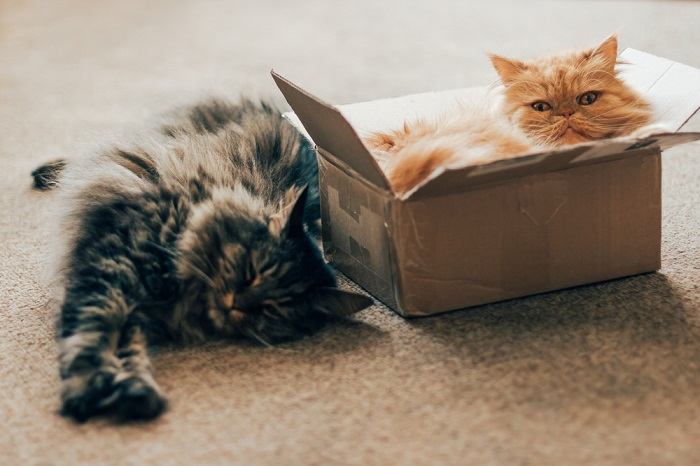
Certain medications may cause insatiable hunger, which can lead to a cat chewing on non-edible items.
Some of our pets are on medication that gives them an insatiable appetite, and no matter what you feed them they still seem hungry. Classic examples include steroids and some anti-seizure drugs.
If your cat is munching on everything in sight, speak to your veterinarian. It might be that the drug dose needs to be altered or you need to explore other strategies to help your pet’s symptoms.
However, you must never stop any of these medications abruptly without speaking to your vet first as this can be extremely dangerous for your pet.
How Can You Stop Your Cat From Chewing Cardboard?
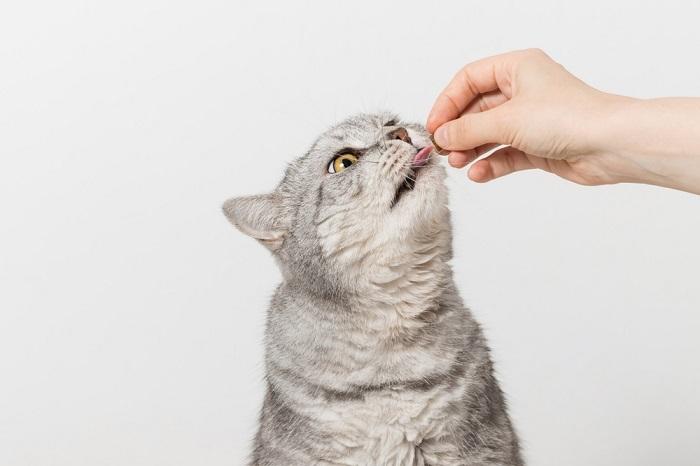
Toys that satisfy your cat’s hunting instincts are great deterrents and rotating toys every week or so can add a bit of extra variety.
As a pet parent, it can be very worrying if your cat likes to chew objects. The first step to prevention is to identify the underlying cause. Boredom can be alleviated by enriching your cat’s environment and activating their different senses so that they feel mentally stimulated.
Enrichment ideas include new cat-safe toys, such as squeaky toys, lasers, catnip-laced soft toys, cat grass from the pet store, and access to a “catio” (an enclosed outdoor space). Toys that satisfy your cat’s hunting instincts are great deterrents and rotating toys every week or so can add a bit of extra variety.
Also Read: The 10 Best Chew Toys for Cats
How you feed your cat can also help curb undesirable chewing; scattering or hiding treats and kibble around your home, feeding kibble ad-lib throughout the day, increasing the amount of fiber in your cat’s diet, and putting food in a kong toy might all help your cat to feel less hungry and less bored.
If your cat is feeling stressed then removing the source of anxiety is a big step. In addition, your vet may be able to recommend pheromone sprays or anti-anxiety supplements and medications for those cats experiencing a significant impact on their mental and physical wellbeing. In some cases, these measures are only effective alongside referral to a feline behaviorist who will be able to help guide you on the best methods to alleviate your cat’s anxiety.
Also Read: 6 Subtle Signs Your Cat Loves You
As well as treating the underlying cause, you can of course hide any cardboard in the house as this will be a big step toward preventing your cat from chewing cardboard. Unfortunately for many of us, this is easier said than done!
Also Read: 10 Tips To Train Your Cat To Sleep All Night
Conclusion: Keep a Close Eye
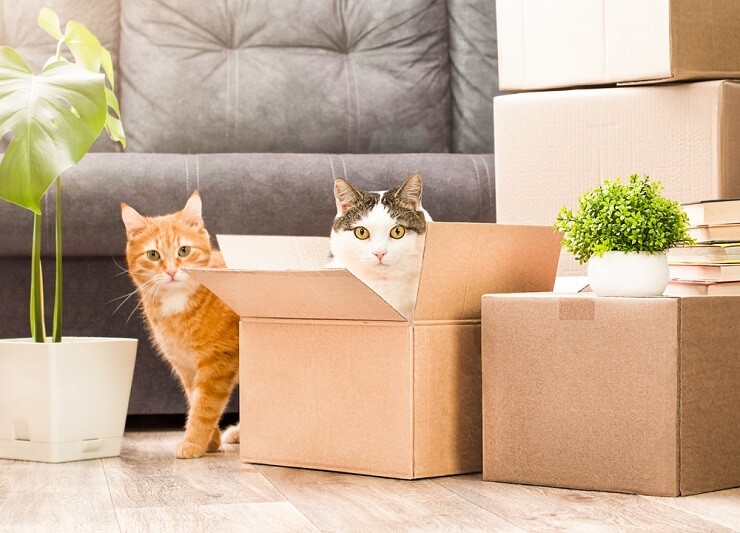
As a pet parent, it can be very worrying if your cat likes to chew objects.
The good news is that most cats that chew cardboard will be absolutely fine! If you are monitoring your cat’s habits closely and doing whatever you can to prevent pica, then you’re doing a great job keeping him safe.
But, if you are worried that your cat is developing compulsive behaviors, he’s eating the cardboard, or he has any unusual symptoms, a call to your veterinarian is most definitely the next step.
Also Read: The 10 Best Cat Slow Feeders & Puzzle Feeders
Frequently Asked Questions
How do you know if your cat has pica?
It can be tricky to work out whether your cat is just chewing weird objects or truly has pica. Watch out for any items that are small enough to fit into your cat’s mouth or have chunks missing, as these pose the highest risk of being eaten.
Sometimes objects will be vomited back up or pass through in your cat’s poop and this is a sure sign that your cat is eating things that he shouldn’t. Perhaps your cat chews objects and he frequently goes off his food or has diarrhea; this might also be an indicator of pica. If you suspect that your cat has pica, then action should be taken as soon as possible.
Is it bad for cats to chew on cardboard?
Destroying cardboard is fine; your cat is enjoying himself and is doing what comes naturally. Chewing on cardboard is more of a concern. Any sharp edges could cause damage to his gums and it’s hard to be sure that he's not eating the cardboard.
The main risk of swallowing cardboard is that it may get lodged in his guts and cause an intestinal blockage. This can cause vomiting, poor appetite, lethargy, and tummy pain, and is considered a critical emergency. If you are worried that your cat has an intestinal obstruction, or that he has swallowed some cardboard, you should speak to your vet clinic immediately.
-
Demontigny-Bédard I, Beauchamp G, Bélanger MC, Frank D. (2016). Characterization of pica and chewing behaviors in privately owned cats: a case-control study. Journal of Feline Medicine and Surgery, 18(8), 652-7. Retrieved July 12, 2022.
-
Demontigny-Bédard I, Bélanger MC, Hélie P, Frank D. (2019). Medical and behavioral evaluation of 8 cats presenting with fabric ingestion: An exploratory pilot study. Canadian Veterinary Journal, 60(10), 1081-1088. Retrieved July 14, 2022.
-
John W.S. Bradshaw, Peter F. Neville, Diana Sawyer. (1997). Factors affecting pica in the domestic cat. Applied Animal Behaviour Science, 52 (3–4), 373-379. Retrieved July 17, 2022.
-
Landsberg GM, Hunthausen WL, Ackerman L. (2013). Stereotypic and compulsive disorders. Behavior Problems of the Dog and Cat. 3rd edition. Saunders, Toronto, Ontario. Retrieved July 12, 2022.
 Fact checked by
Fact checked by

